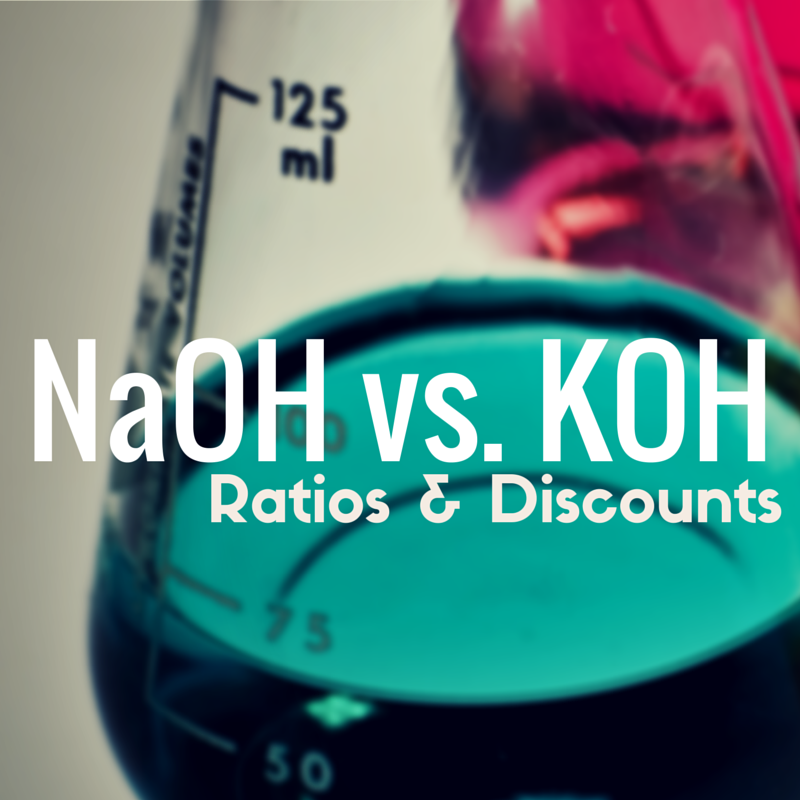Last time, we discussed the basic process of making soap, and talked about how a lye solution and fat react during the saponification process.
This time, we’re going to go beyond the basics (ha!) of lye. Remember, there are two types of lye used in soap making: sodium (NaOH) and potassium (KOH) hydroxide.
These two alkali salts, when mixed with water and added to the same fats, can produce considerably different end products. In this post, we’ll figure out the differences between NaOH and KOH, talk about ratios when mixing both, and cover superfatting/lye discounting.
NaOH and KOH produce chemically different results of saponification. When one of them is dissolved in water and added to fats, the hydroxide group of the lye joins the triglyceride, cleaving it into a fatty acid and most of a glycerol, and leaving behind the sodium or potassium ion. Then, the hydrogen from the hydroxide group moves to complete the glycerol, and the lonely sodium/potassium ion replaces it.
When saponification is complete, the sodium or potassium ion will bond with the fatty acid, producing a different compound in each case. For example, stearic acid would produce sodium stearate or potassium stearate. These two substances have different physical properties.
Note that you don’t need to understand this chemical process. You just need to understand that NaOH and KOH can produce different results using the same fats.
NaOH vs KOH
Sodium hydroxide will produce a hard soap. It’s normally used to create the bar soap you’d use in the shower.
Potassium hydroxide creates a softer soap. Normally, it’s used to produce liquid soap; but if you use a similar proportion of KOH as NaOH, it will create a soft, putty-like soap.
Sodium hydroxide (NaOH) and potassium hydroxide (KOH) are pretty similar. They’re both caustic substances, release heat when reacting with water, can be dangerous when mishandled, and turn fat into soap. However, they do have a few more differences than just hardness:
- Cost: KOH is about 30% more expensive than NaOH.
- Heat: KOH produces a little more heat when reacting with water.
- Source: KOH is from wood ashes, while NaOH is industrially produced by electrolysis of NaCl (salt) in water. (Most of the chlorine gas produced worldwide is a byproduct of this electrolysis.)
- Soap solubility: KOH soaps tend to be a little more soluble than NaOH soaps. This is important for us because it may affect how easy it is to lather the soap, depending upon how soluble it was to begin with. If an ingredient like stearic acid makes the soap less soluble in water, KOH can be used to balance this out.
As you’ve probably realized, the only really important differences here are the physical properties of the soap produced. However, these can go beyond simple hardness.
For example, some soap makers find stearic acid difficult to use with NaOH, because it saponifies too quickly and makes the soap difficult to stir. On the other hand, KOH allows the soap to move slower, and can give it a better lather.
Ultimately, these specific differences are a great reason to research your ingredients. Don’t waste your ingredients on a mistake somebody else has already made!
NaOH:KOH Ratio
Many shaving soaps use a blend of NaOH and KOH. This way, you can fine-tune the hardness of a soap and get some of the benefits of each alkali. Beginners are sometimes confused about how to calculate the amount required for each. In reality, it’s simpler than you might think.
Let’s say for example that your soap recipe calls for 10.00g NaOH.
To convert between NaOH and KOH, you can multiply NaOH or divide KOH by the ratio of their molecular weights: 1.403. So in this case, you could use 10.00g NaOH, or 14.03g KOH.
Now, let’s say you want to use 60% KOH and 40% NaOH. This is a common starting ratio when formulating a shaving soap.
You just multiply the amount of lye required by the proportion you want as a decimal. So in this scenario:
KOH = 14.03 x 0.6 = 8.418g. NaOH = 10.00 x 0.4 = 4.00g.
So you would use 4g of NaOH and 8.418g of KOH.
For a fantastic video about the differences between NaOH and KOH ratios, check out Kevin Devine on Youtube. He tests a range of lye ratios and stearic acid content in shaving soap. Then, he shows how well they lather 1.5 weeks later.
Lye Discounting AKA Superfatting
If you’re familiar with the soap making process, you will have heard the terms discount or superfat. They both mean more or less the same thing: using more fat than a given amount of lye requires.
Usually, soap is superfatted by adding extra fat once the first lot has undergone saponification. This technique is important for two reasons:
- Superfatting allows the fat that’s added after saponification to (theoretically) remain untouched by the lye. This means it can impart its moisturizing and other qualities to your soap.
- Perhaps more importantly, superfatting provides a buffer against extra lye. If there is unreacted lye in your finished soap, it’s going to be pretty awful to use. Although you should be as precise as possible, superfatting gives you a margin of error for your measurements.
Lye discounting is similar – simply reduce the amount of lye required by a few percentage points. Rather than adding a specific superfat, the soap just retains a little bit of every fat you used.
Keep in mind that although superfatting is a great technique to improve your soap, you can have too much of a good thing. If you superfat at too high a percentage, your soap will be greasy. Superfatting using an additional ~3% of the weight of your total fat is generally a good place to start.
——————————
That’s it, shavers & soapers! While I’m trying to keep the math and chemistry to a minimum, I hope this post helped you understand more about why you might use NaOH or KOH in a recipe.
Thanks for reading! Got any questions or comments? Let me know in the comments section below!
Catch you next time,
Lewis


Great article on superfatting. I have had the best luck with at 60/40 or 50/50 ratio myself. A lot depends on the oils and fats used as well. Keep up the great articles.
Most suppliers here seem to supply NaOH as ‘Caustic Soda’ in either flakes or pearls. Pearls appear to be cheaper by weight than flakes. Is there any advantage to using one over the other? Are there any conversions to take into consideration when using pearls rather than flakes?
2 things first
I am totaly beginner in soap making
I anm not a native Englisch (so excuse me for mistakes)
I find always the use of NaOH or KOH (whem I add water I get lye)
I absolutely want to use homemade lye (leeching wood ashes) I alraedy find the lye has to be strong so one fresh egg will floatt in it.
Can some one tell me how much KOH plus how much water also gives a lye where a fress egg floatt in.